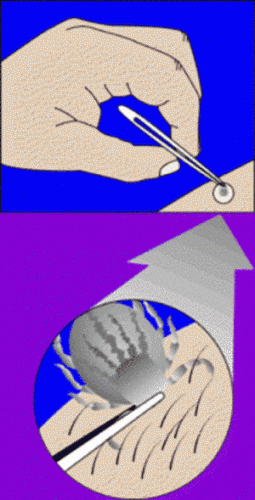Tick Prevention for Dogs and Cats

Ticks are most prevalent during the summer months. Avoiding tick habitats, such as forest and scrub, during this time of the year is advisable. Pets should be treated with tick prevention products and checked daily during the tick season. If seen, ticks should be removed immediately.
Much like heartworm, when it comes to ticks prevention is better than cure. Getting rid of ticks before they cause disease, either by avoiding them altogether, removing them promptly from pets, or at last resort killing them, is the best policy. Products which kill ticks are called "acaracides".
There are many measures which can be used to deter ticks from the immediate home environment. Where possible, start by destroying tick habitats. Cutting or removing grass, weeds, shrubs and garbage piles between fences and along property lines and buildings will reduce tick numbers by reducing the sort of places they like to hide. It will also minimise the number of protected environments capable of harboring wild animals, which can serve as hosts for juvenile stages of ticks.
Effective compounds for outdoor environmental tick control include carbaryl, cyfluthrin, permethrin and s-fenvalerate.
If Brown Dog Ticks are found in buildings, acaracides such as cyfluthrin and permethrin should be sprayed into cracks and crevices, behind and under furniture and along the boards in the floors and ceiling, as ticks will often hide in these areas.
|
Anti-tick treatments
|
Pet Shed's most popular solutions for ridding your pet of ticks
|
Freshly-applied acaracides should be allowed to dry before animals or humans are allowed back into the area, as inhaling these chemicals can be hazardous. It is often best to have a licensed specialist exterminator apply acaracides, both indoor and outside.
Avoiding tick habitats, such as woodland areas, tall grass and bush areas and mountainous areas is also advisable during the tick season. Avoid walking your dog in such areas from about May to September. The tick season duration varies from state to state, so consult your veterinarian for accurate local information.
The animal should also be treated with an effective preventative product. There are several options available, such as tick collars, washes or topical products. Amitraz, permethrin and fipronil are some of the effective ingredients which help to kill and/or repel ticks. Your veterinarian can advise which is the most appropriate for your pet.

Even when preventative products are used, pets should also be examined daily during tick season. Owners are advised to check in ears, between toes, under lips, at the back of the neck, in the armpits, under your pet's collar, around genitalia and under the tail. Ticks tend to be found in areas where the animal is unable to lick or bite.
If a tick is found on a pet, it should be removed immediately. The best way is with a 'tick scoop' or fine tweezers. Do not use your fingers. The tick should be grasped as close to the skin as possible, then extracted by pulling directly outwards using slow, steady pressure until it releases its grip.
The tick should not be crushed, twisted or jerked out, as this could cause the head to become detached and left behind, which can lead to infection. If the head is left in the skin, it should be removed with a needle (like removing a splinter). It is advisable to wear disposable gloves when removing ticks, and to wash ones hands in soap and water afterwards, even if there has been no physical contact with the tick.
The bite wound on the pet should be gently washed out with antiseptic after the tick has been removed, to prevent any infection in the wound site
It is a good idea to keep the tick in a glass jar to assist your veterinarian in making a diagnosis in the event a tick-related disease is suspected. If ticks are removed within four to six hours of attachment, they are unlikely to have transmitted any diseases.
Note that rubbing petroleum jelly or alcohol onto the tick, or holding a hot match head to a tick are not effective in removing them from a pet's skin. Apart from the potential to accidentally burn your pet , these methods may actually cause the tick to salivate or regurgitate, and transmit any diseases it is carrying.
|
References
|
| Farley D. Fighting Fleas and Ticks. In: FDA Consumer. US Food and Drug
Administration. 30:6, 1996. http://www.fda.gov Payne, P.A., Dryden, M.W., Carter,G.R. External Parasitic Diseases of Dogs and Cats. In: A Concise Guide to Infectious and Parasitic Diseases of Dogs and Cats International Veterinary Information Service, Ithaca NY. www.ivis.org Tilley L.P., Smith, F.W.K. The Five Minute Veterinary Consult Canine and Feline. Second Edition. Lippincott Williams & Wilkins, Baltimore, 2000. Vredevoe L. Background Information on the Biology of Ticks. Department of Entomology, University of California, Davis. http://entomology.ucdavis.edu What you should know about External Parasites. American Veterinary Medical Association. Schaumberg, IL. www.avma.org |